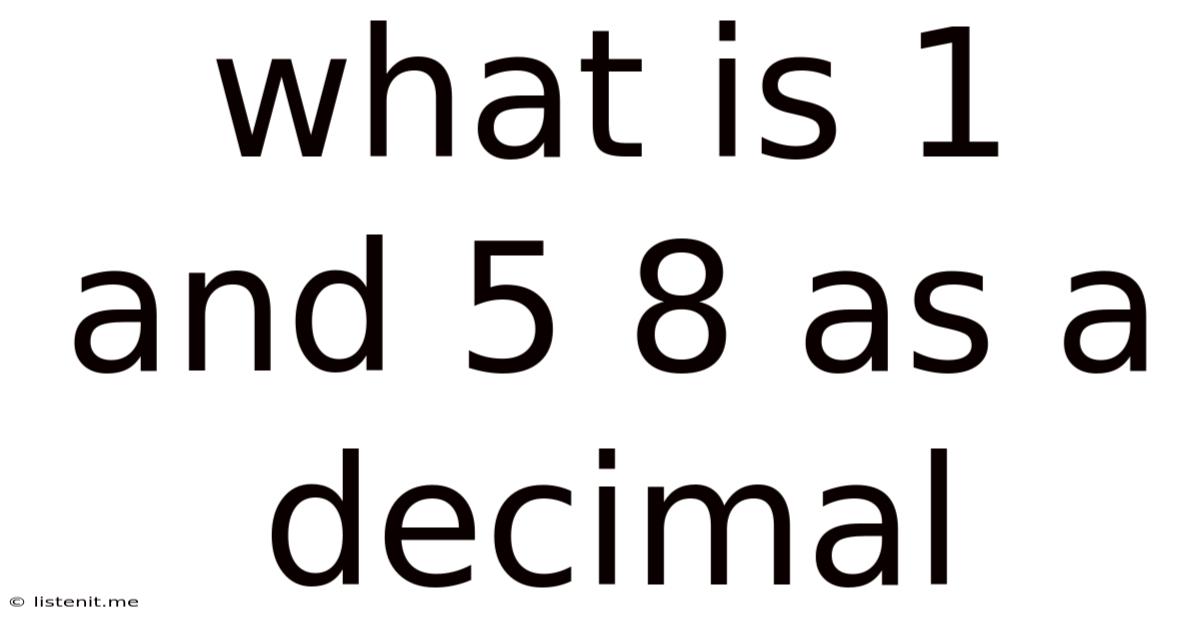What Is 1 And 5 8 As A Decimal
listenit
May 12, 2025 · 5 min read

Table of Contents
What is 1 and 5/8 as a Decimal? A Comprehensive Guide
Converting fractions to decimals is a fundamental skill in mathematics with applications spanning various fields, from simple everyday calculations to complex scientific computations. This comprehensive guide will walk you through the process of converting the mixed number 1 and 5/8 into its decimal equivalent, exploring different methods and offering a deeper understanding of the underlying concepts. We'll also touch upon the importance of this conversion in various contexts and provide you with some practical applications.
Understanding Mixed Numbers and Fractions
Before diving into the conversion, let's clarify the terms involved. A mixed number combines a whole number and a fraction, like 1 and 5/8. This represents one whole unit plus five-eighths of another unit. A fraction, on the other hand, expresses a part of a whole, consisting of a numerator (the top number) and a denominator (the bottom number). In 5/8, 5 is the numerator and 8 is the denominator.
Understanding these basic concepts is crucial for effectively performing the conversion.
Method 1: Converting the Fraction to a Decimal, Then Adding the Whole Number
This is arguably the most straightforward approach. We'll first convert the fraction 5/8 to a decimal and then add the whole number 1.
Step 1: Divide the Numerator by the Denominator
To convert a fraction to a decimal, we simply divide the numerator by the denominator. In this case, we divide 5 by 8:
5 ÷ 8 = 0.625
Step 2: Add the Whole Number
Now, we add the whole number part (1) to the decimal equivalent of the fraction (0.625):
1 + 0.625 = 1.625
Therefore, 1 and 5/8 as a decimal is 1.625.
Method 2: Converting the Mixed Number to an Improper Fraction, Then to a Decimal
This method involves an intermediate step where we convert the mixed number into an improper fraction before converting it to a decimal. An improper fraction is a fraction where the numerator is greater than or equal to the denominator.
Step 1: Convert to an Improper Fraction
To convert a mixed number to an improper fraction, we multiply the whole number by the denominator, add the numerator, and keep the same denominator.
(1 × 8) + 5 = 13
So, 1 and 5/8 becomes 13/8.
Step 2: Divide the Numerator by the Denominator
Now, we divide the numerator (13) by the denominator (8):
13 ÷ 8 = 1.625
This confirms that 1 and 5/8 as a decimal is 1.625.
Method 3: Using Decimal Equivalents of Common Fractions
For frequently used fractions, it's beneficial to memorize their decimal equivalents. Knowing that 1/8 = 0.125, we can easily calculate the decimal equivalent of 5/8:
5/8 = 5 × (1/8) = 5 × 0.125 = 0.625
Adding the whole number 1, we get 1.625. This method is efficient for those familiar with common fraction-decimal conversions.
Significance and Applications of Decimal Conversions
The ability to convert fractions to decimals is crucial in various applications:
- Everyday Calculations: Dividing items equally, calculating percentages, or comparing quantities often involves decimal numbers.
- Scientific and Engineering Fields: Precision measurements and calculations in fields like physics, chemistry, and engineering rely heavily on decimal notation.
- Financial Calculations: Dealing with money involves decimal representation, whether calculating interest, taxes, or budgeting.
- Computer Programming: Many programming languages use decimal numbers for representing and manipulating data.
- Data Analysis and Statistics: Data analysis and statistical computations often require converting fractions to decimals for ease of calculation and interpretation.
Practical Examples Using 1.625
Let's illustrate some practical applications of the decimal equivalent 1.625:
-
Measurement: Imagine you have a piece of wood measuring 1 and 5/8 inches. Using the decimal equivalent, you can easily express this as 1.625 inches, which is more convenient for calculations involving other measurements.
-
Baking: A recipe might call for 1 and 5/8 cups of flour. Using the decimal equivalent, 1.625 cups, can make it easier to measure accurately using a measuring cup with decimal markings.
-
Finance: If you earn $1 and 5/8 per hour, your hourly wage is $1.625. This simplifies calculations of your total earnings.
-
Engineering: In engineering drawings, dimensions are often expressed in decimals, making the use of 1.625 more practical than a mixed number.
Troubleshooting Common Mistakes
While the conversion process is relatively straightforward, some common mistakes can occur:
- Incorrect Division: Ensure you correctly divide the numerator by the denominator. A simple arithmetic error can lead to an incorrect decimal result.
- Forgetting the Whole Number: Always remember to add the whole number back to the decimal equivalent of the fraction.
- Rounding Errors: If rounding is necessary, be consistent and use appropriate rounding rules to avoid significant errors, especially in scientific or engineering applications.
Conclusion: Mastering Decimal Conversions
Converting fractions, including mixed numbers like 1 and 5/8, to their decimal equivalents is a fundamental mathematical skill with wide-ranging applications. Understanding the different methods and practicing the conversion process will build confidence and efficiency in various numerical computations. Whether you're tackling everyday tasks or complex scientific problems, the ability to confidently navigate between fractions and decimals is an invaluable asset. Remember to practice regularly and utilize different methods to solidify your understanding and choose the most efficient approach based on the context of the problem. By mastering this skill, you'll unlock a more comprehensive understanding of numerical systems and improve your ability to solve a wider range of mathematical problems.
Latest Posts
Related Post
Thank you for visiting our website which covers about What Is 1 And 5 8 As A Decimal . We hope the information provided has been useful to you. Feel free to contact us if you have any questions or need further assistance. See you next time and don't miss to bookmark.